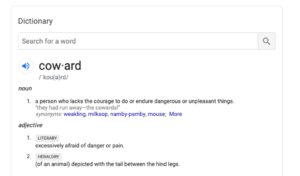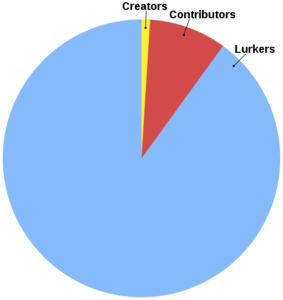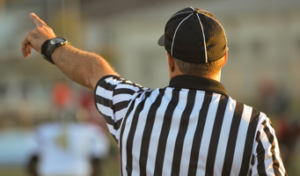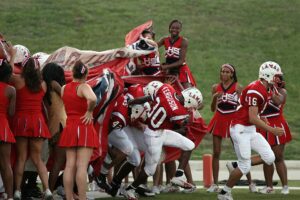I’ve been a LinkedIn coward, for years, and I’m finally ready to admit it.
Most of you are cowards too. Coward is a strong word, but it fits, and your cowardice could be hurting your LinkedIn connections.

Does it make you feel better if I use milksop or namby-pamby to describe us? Maybe if I call us “lurkers” instead? Apparently “lurker” is the term applied to us under the “1% Rule”. That’s a rule that states that
- 1% of website participants create
- 9% contribute, and
- 90% lurk.

Said another way, most of us just watch.
Online it’s accepted that the 1% rule is technically inaccurate, yet it’s embraced. In that way it’s much like the “80/20 Rule” we apply everywhere without evidence. Both rules speak to basic truths in our life experience.
The 1% truth? We lurk online. We watch. We wonder. We anticipate and evaluate, but we rarely engage. For me, that tendency to lurk grew from fear. I spent years afraid of being active online. Why?
What if I got it wrong?
As silly as it seems as I write it out now, that is how I thought about participating on LinkedIn. When I thought about doing something as simple as liking or commenting on a post, I thought I was, well . . . the referee.

I saw a post from a connection as an opportunity to “make the call” about the content. Was it good? Could I be insightful? Could I add extreme value to everyone who came after and saw my comment? Could I make the right call?
I would actually think, “that article was OK, but it could have been better in these three ways, so I’ll withhold my like until a better one comes along.”
Silly right? But it was my mindset, and I was in good company. Come on fellow lurkers, you know you’ve done it. You’ve typed out an authentic comment to a post and then you’ve hesitated. You re-read the comment over and over until you just got tired and deleted it. It’s ridiculous to consider the thinking behind this, but I really thought there was something important to my role of content referee.
Some on LinkedIn play the referee role energetically. And if that role does it for you, more power to you. For me, I was remarkably timid in that referee role. Without much effort, I would second-guess myself right out of participating at all. I would come up with some good reason why I shouldn’t like, comment or share the article. I can always come up with a good reason NOT to do something.
So, no surprise, I found very little value from the time I was spending on LinkedIn. But that changed when I finally asked:
What do my connections on LinkedIn need?
They certainly didn’t need me to be a referee.
I realized I was on LinkedIn to learn, meet new connections, build relationships with others, and see if I could find situations where those connections and I could help each other grow our businesses. But that was not happening. And it wasn’t happening because I wasn’t doing anything my connections found helpful.
- I wasn’t liking.
- I wasn’t commenting.
- I wasn’t cheering.
- I wasn’t even booing.
It was time for a change. Here’s what I’m trying to do now.

Behold, Your New Cheerleader on LinkedIn
More and more I’m trying to act like a cheerleader when I’m on LinkedIn. I try to approach content my contacts post like this:
- My connection “Bill” is on my professional team, and I want to support him.
- I see Bill has posted something.
- If I don’t have time to give Bill’s post a full, thoughtful consideration (still my preference), I will try to find some reason to like or comment on Bill’s post. Even if it’s just a “Thanks for posting.”
I’m certainly not an expert on cheerleading (perhaps you picked that up from the facial expression), but I know a key part of doing that job is making the team feel supported when they step on the field, not just when they make a spectacular play.
I’m not talking about liking every single post – that would be like the cheerleader screaming indiscriminately on the sideline the entire game. But I am trying to pay more attention to, and acknowledge, the effort it takes to just show up.
I’m trying to be a decent cheerleader, and as it turns out, my LinkedIn connections (and yours) are in desperate need of cheerleading. Their ability to stay on the field might actually depend on it.

How LinkedIn Works
How does LinkedIn work? How do they decide what content goes where? I have no idea, but a blog by Rushi Bhatt on the LinkedIn Engineering site might help shed some light. In the post, Bhatt tries to: . . .describe the various processes and algorithms that keep our feed cleared of spam and relevant to our members.
What happens when your connection posts something? Bhatt describes the process that occurs this way:
As it gathers audience: We continuously predict whether a share is likely to go viral. For this prediction, we monitor the network reach of the original poster, members interacting with the content, and the temporal signals like the velocity of likes, shares, and comments, in addition to the computed content quality scores. Our classifiers run every few hours on our Hadoop clusters to identify shares that are likely to go viral and are likely to be of a lower quality. We utilize random forest classifiers and gradient boosted trees for this prediction.
First, to be clear, I don’t understand what that means. I’ve no idea what Hadoop clusters or boosted trees are.
What I have gleaned from this, and other similar articles, is that LinkedIn evaluates content through its fancy computer tricks, but also based on the engagement response generated by a relatively small, initial post audience.
LinkedIn essentially says, “in addition to the computer stuff, let’s run it by a few folks and see if anyone cheers (or boos)”.
Meaning, if you see a post, and breeze by it, you might be one of a very small group of people that ever see that post. So your choice to “lurk” might mean that your contact’s post doesn’t make the cut to a wider audience.
Get that? Say your co-worker’s post has a test run that goes to 30 people, and you’re one of those people. No one responds. Your connection is potentially kicked off the field to make room for someone else. Your connections need an occasional cheerleader.
Do you ever cheer?
Do you even boo?
Side Note: Do you know how thrilled I am to get a “boo” on a post? A boo might be a response to a post like “Hey Mike, disagree with you on this one. Here’s why . . .”. That’s engagement! Conversation! Human interaction! Booing is far better than silence, and often better than cheering. In fact, my dream is that everyone who reads this post will comment “This is the worst post I’ve ever read on LinkedIn!” Imagine the impact of walking onto the field and having the entire stadium boo. It gives me chills.
5, 6, 7, 8 . . .Who Do We Appreciate?
Your connections are posting.
You are lurking. Stop.
Throw away the referee’s stripes and pick up a pair of pom-poms.
Your connections need a cheerleader – even a middle-aged, lethargic, reluctant, judgmental one will do. If you want to see your time on LinkedIn start to pay off, find something to cheer about
That’s what I’ve been doing — and it’s been working!
Game on. Feel free to join my cheerleading squad. Obviously, our standards are remarkably low.